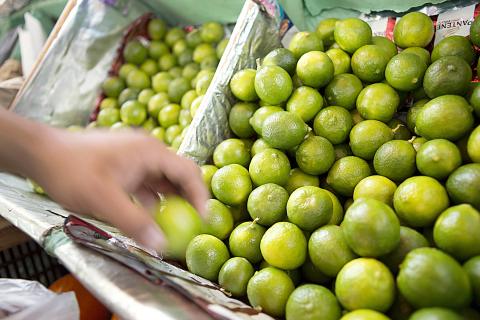Every time a bartender at trendy Los Angeles fusion eatery Luna Park squeezes a shot of lime into a drink these days, owner Peter Kohtz says he winces a little.
Luna Park, known for its large selection of craft cocktails, is one of thousands of restaurants from coast to coast that have fallen victim to the Great Green Citrus Crisis of 2014 — a severe shortage of limes that has meant that the fruit has skyrocketed in price in recent weeks.
A case of 200 or so fetches between US$80 and US$130 now, up from about US$15 last year — the result of a perfect storm of circumstances from citrus disease that struck Florida in 2001 and wiped out most lime groves to the increasing reach of drug cartels to disrupt supplies in Mexico, the biggest US supplier.

Photo: bloomberg
The cost might not seem like that big of a deal until one realizes that it’s lime juice that’s squeezed into every margarita, mojito or mai tai. It’s also lime that’s chopped up and mixed with fresh fish to create ceviche. It’s lime, mixed with avocado, that makes up guacamole — a mainstay at every Mexican restaurant.
“It’s just one of those things that you take for granted. You never really think about it because it’s always there,” said Kohtz, noting his bartenders squeeze an entire lime’s worth of juice into most specialty drinks.
So far, the price spike doesn’t seem to have been passed on widely to consumers, according to industry officials, but people are beginning to notice it in other ways.

Photo: reuters
Alaska Airlines stopped putting limes in in-flight beverages a couple of weeks ago. At a recent luncheon meeting of the California Restaurant Association’s board of directors, association spokeswoman Angie Pappas said limes were noticeably absent from the buffet bar, which featured Mexican food.
One of the luncheon attendees, a Southern California restaurateur, told her he is offering a free appetizer to any customer who brings in a bag of limes from their backyard tree. In Phoenix, the Arizona Republic reports that a bar and restaurant group is offering a free cocktail, glass of wine or beer to anyone who brings in 5 pounds of limes.
Which raises the question, if limes grow on backyard trees in Los Angeles and Phoenix, why are they so expensive? Because they don’t really grow well enough in most of the US to be produced commercially, says Jonathan Crane, a tropical fruit crop specialist at the University of Florida’s horticultural sciences department.
Until 2001, Crane said, Florida produced half of all the limes consumed in the US. But then a devastating citrus canker outbreak led officials to order almost all of Florida’s lime groves destroyed and the industry never recovered.
Mexico began producing more than 90 percent of the limes now consumed in the US.
In most of California, the weather isn’t warm or humid enough to produce commercial quality limes, and the state has only a few hundred acres in production near the Mexican border.
DRUG CARTELS
Mexico’s crop, meanwhile, was hit by a myriad of problems this year, including flooding in some areas and interference from the Knight Templer drug cartel, which jacked up prices by disrupting deliveries and shaking down farmers.
Like American mobsters, the drug cartel that controls much of the Mexican state of Michoacan where both limes and marijuana grow in abundance, has been muscling in on legitimate businesses.
A Mexican official told The Associated Press last month the cartel extorts as much as US$1.4 million a week from legitimate businesses, mainly lime and avocado growers. In some instances, he said, the cartel is now running some of the state’s wholesale lime distribution centers where prices are set.
Last winter’s storms, which triggered major floods across western Mexico, also destroyed crops, and a plant disease that struck the Mexican state of Colima damaged still more.
The result, the price of limes has shot up dramatically in both Mexico and the US Restaurants in Seattle and New York have reported paying as much as US$130 a case for them.
As the industry waits for the summer crop to lower prices, some restaurants and bars nationwide are pulling lime drinks off their happy hour menus. Others are substituting ingredients like lemons or oranges, said Annika Stensson of the National Restaurant Association.
That’s not an option at El Coyote, says Wayne Christoffersen, manager of the popular Mexican eatery that’s been a fixture with Hollywood’s hipster and film industry crowd since opening in 1931.
“People want to see a lime in their margarita, and rightfully so,” says Christoffersen, who is paying US$80 a case for them. “A margarita’s not a margarita without the lime.”
Independent filmmaker Laura Bahr, who has downed her share of margaritas, says if anyone dared put anything but a lime in her drink she’d likely never go back.
“The lime mixed with the tequila is just a winsome combination,” she says. “Like peanut butter and jelly.”
So until the price spike ends, Kohtz of Luna Park says he’s come up with the only alternative he can think of.
“I tell the bartenders, `Squeeze those limes extra hard. Squeeze out every drop you can.”’

This year will go down in the history books. Taiwan faces enormous turmoil and uncertainty in the coming months. Which political parties are in a good position to handle big changes? All of the main parties are beset with challenges. Taking stock, this column examined the Taiwan People’s Party (TPP) (“Huang Kuo-chang’s choking the life out of the TPP,” May 28, page 12), the Democratic Progressive Party (DPP) (“Challenges amid choppy waters for the DPP,” June 14, page 12) and the Chinese Nationalist Party (KMT) (“KMT struggles to seize opportunities as ‘interesting times’ loom,” June 20, page 11). Times like these can

June 23 to June 29 After capturing the walled city of Hsinchu on June 22, 1895, the Japanese hoped to quickly push south and seize control of Taiwan’s entire west coast — but their advance was stalled for more than a month. Not only did local Hakka fighters continue to cause them headaches, resistance forces even attempted to retake the city three times. “We had planned to occupy Anping (Tainan) and Takao (Kaohsiung) as soon as possible, but ever since we took Hsinchu, nearby bandits proclaiming to be ‘righteous people’ (義民) have been destroying train tracks and electrical cables, and gathering in villages

Dr. Y. Tony Yang, Associate Dean of Health Policy and Population Science at George Washington University, argued last week in a piece for the Taipei Times about former president Ma Ying-jeou (馬英九) leading a student delegation to the People’s Republic of China (PRC) that, “The real question is not whether Ma’s visit helps or hurts Taiwan — it is why Taiwan lacks a sophisticated, multi-track approach to one of the most complex geopolitical relationships in the world” (“Ma’s Visit, DPP’s Blind Spot,” June 18, page 8). Yang contends that the Democratic Progressive Party (DPP) has a blind spot: “By treating any

Swooping low over the banks of a Nile River tributary, an aid flight run by retired American military officers released a stream of food-stuffed sacks over a town emptied by fighting in South Sudan, a country wracked by conflict. Last week’s air drop was the latest in a controversial development — private contracting firms led by former US intelligence officers and military veterans delivering aid to some of the world’s deadliest conflict zones, in operations organized with governments that are combatants in the conflicts. The moves are roiling the global aid community, which warns of a more militarized, politicized and profit-seeking trend